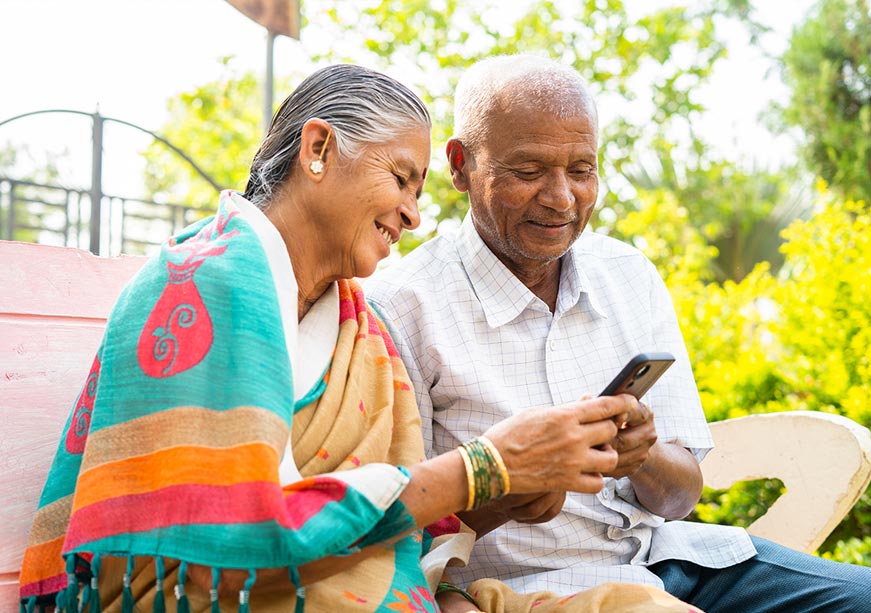-
CENTRES
Progammes & Centres
Location
Technology can empower India’s elderly—but without digital skills, it is more likely to isolate them. Bridging this gap is urgent.

Image Source: Getty
Ageing has many disadvantages, including higher health risks, physical and cognitive decline, social isolation, and even poverty. While some of these challenges, particularly increased health risks associated with ageing, feature prominently in the discourse on elderly welfare in India, the role of technology in elderly welfare is often ignored. An average person today connects to the internet for work, information, education, entertainment, socialisation, and even to buy essential commodities. Technology has also improved public service delivery and addressed the systemic leakages that characterised India’s public welfare system. In short, access to technology is essential for independent living and holistic well-being. However, technology also has the power to exacerbate existing inequalities and further exclude vulnerable sections of society. This is particularly true for the elderly in developing countries, who have poorer access to digital technologies and often lack technical skills.
An average person today connects to the internet for work, information, education, entertainment, socialisation, and even to buy essential commodities.
Experts like Ana Maria Carrilo Soubic assert that age adds to factors, such as gender, education, and socioeconomic background, contributing to digital exclusion. Therefore, while a small section of the elderly population that is highly educated and affluent can access essential goods and services, stay in touch with family members, and lead an independent life using digital technologies, globally, there still exists a huge digital divide between the young and the old, also known as the grey digital divide. Within the elderly, older women, particularly those who are uneducated, located in rural areas of developing countries, and from marginalised groups like scheduled castes, are least likely to have digital access. Even in developed regions like the European Union, only half as many women in the age group 55–74 years have basic or above basic digital skills compared to men and women in younger age groups. Digital gender gaps are wider for women above 75 years of age. Higher technology penetration might pose risks of further exclusion and marginalisation for them. For instance, digitalisation makes it more difficult for the elderly to book tickets or claim old-age benefits, making them more dependent on others. Older people are also falling prey to digital scams and online financial fraud.
According to a recent study by the Agewell Foundation, a non-profit organisation working for elders, about 85 percent of India’s elderly are digitally illiterate (i.e., 76.5 percent elderly men and 95 percent elderly women). Further, the study finds that over 75 percent of the digitally illiterate elderly persons feel that the lack of digital skills adversely affects their well-being and causes isolation and marginalisation. Nearly 85 percent of respondents reported that their younger family members avoided them as they could not understand their lifestyle or language, which was heavily dominated by technology and gadgets. Scholars Basabadatta Jena and Tattwamasi Paltasingh find that the lack of digital literacy is the main reason behind the lower adoption of Information and Communication Technology (ICT) in older Indian adults. Further, there is a huge digital divide between rural and urban areas in India.
Training India’s elderly population in digital skills will help them enjoy most activities, become self-reliant, boost their confidence, and change the perception of elderly individuals as independent and contributing members of society.
Given the role of technology in independent living, intergenerational bonding, and well-being in general, it is important to bridge the grey digital divide by equipping the elderly with basic technical and digital skills. Training India’s elderly population in digital skills will help them enjoy most activities, become self-reliant, boost their confidence, and change the perception of elderly individuals as independent and contributing members of society. As India ages, there is a growing cohort of elders in their 60s and 70s who are physically fit and capable of working. Given the low coverage of pensions in India, with longevity, a substantial proportion of them also need to work for longer years. Keeping abreast with the latest technology will also improve their employability and help them be financially secure in old age.
A community-based digital capacity-building programme for elders is imperative to help them live longer and more fulfilling lives.
Formal recognition of the need for lifelong learning in India happened in the mid-sixties with the Kothari Commission Report 1964-65. It stated, “In a modernising and rapidly changing society, education should be regarded, not as a terminal but as a life-long process.” The National Education Policy (NEP) 2020 also emphasises adult education and inculcating a mindset of continuous skill and knowledge acquisition. The NEP stresses an adult curriculum framework that will impact critical life skills, which include digital literacy, financial literacy, commercial skills, health care awareness, and the creation of ICT-enabled Adult Education Centres. Unfortunately, elders have fewer opportunities to learn computer applications and avail themselves of digital training in India. The Indian government’s Digital Saksharta Abhiyan (DISHA) or India’s National Digital Literacy Mission acknowledges the importance of imparting basic ICT skills to help citizens use IT applications, enhance livelihood opportunities, and participate effectively in democratic processes. Under this scheme, one member of every household will be equipped with essential digital skills. However, this scheme is only for persons below 60 years of age.. As India observes the inevitable process of a population ageing due to rising longevity and falling death rates, it must ensure people of all ages are technologically empowered. A community-based digital capacity-building programme for elders is imperative to help them live longer and more fulfilling lives. While designing digital capacity-building programmes for elders, Indian policymakers must be cognisant of the heterogeneity of their elderly population. Soubic stresses that digital capacity-building programmes should be need-based and tailored to the specific needs of the targeted population. Social norms also play a significant role in preventing elders from accessing training. This is likely to be particularly true for elderly women, who are either illiterate or have received only a few years of formal education. Therefore, efforts must also be made to change social norms governing elderly lives.
Malancha Chakrabarty is a Senior Fellow and Deputy Director (Research) at the Observer Research Foundation.
The views expressed above belong to the author(s). ORF research and analyses now available on Telegram! Click here to access our curated content — blogs, longforms and interviews.

Dr Malancha Chakrabarty is Senior Fellow and Deputy Director (Research) at the Observer Research Foundation where she coordinates the research centre Centre for New Economic ...
Read More +